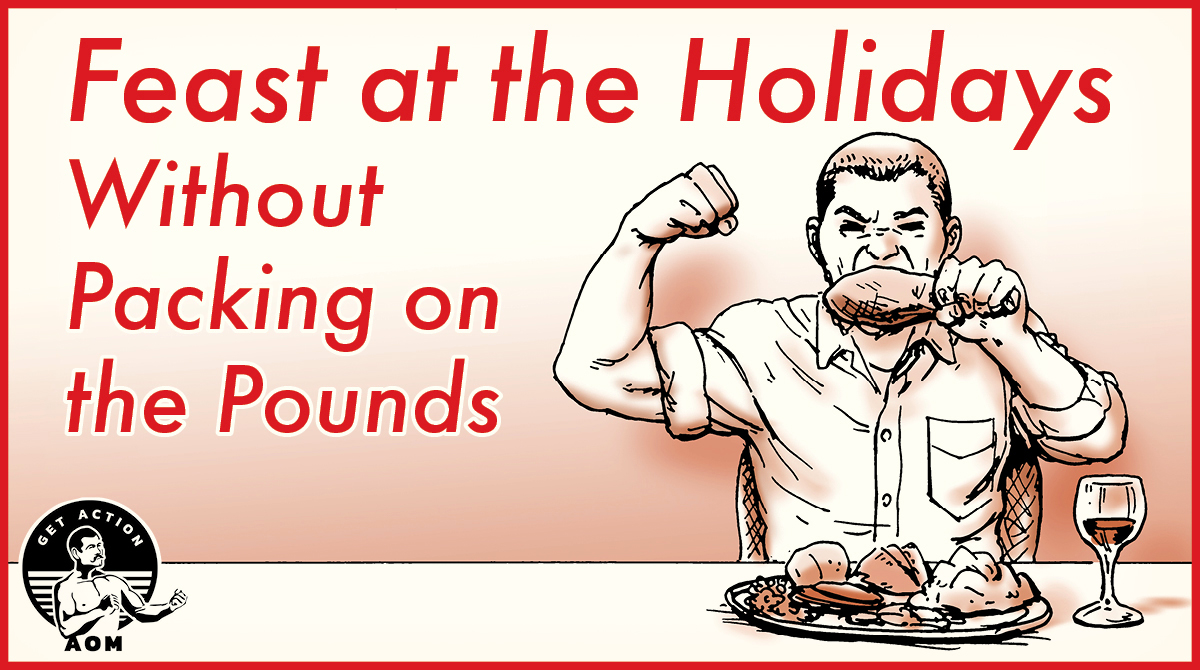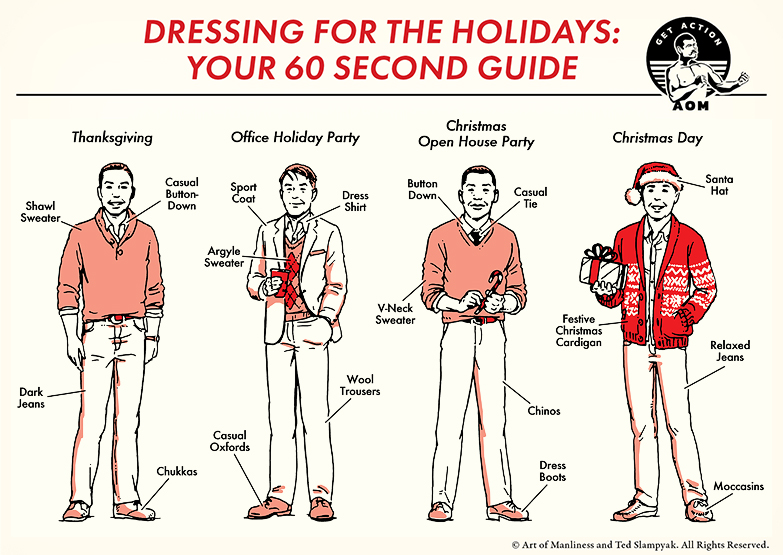
The holidays are just around the corner and that means food.
Lots and lots of delicious food.
Turkey, sweet potato casserole, stuffing, rolls, pumpkin pie. Mmm . . . mmm . . . mmm.
My mouth is watering just typing that out.
You hit that smorgashboard at Thanksgiving and then a month later you’re doing it again at Christmas, and in-between there are often parties, gift baskets, and dropped-off platters of cookies to wade through.
While holiday feasting is great for activating the pleasure centers in your brain, it’s not so great for your waistline. All that tasty carby and fatty food eaten in excess can put on the pounds. In fact, most people do indeed gain about 1 to 2 lbs during the holiday season. That may not sound like much, ‘til you consider that adding 2 pounds of fat each year for 30 years will leave you 60 pounds overweight. That’s a recipe for a bowl-of-jelly-esque belly.
So how can you enjoy those holiday meals without throwing off your nutrition plan? Are you doomed to eating just the celery and carrot sticks your mom puts out as a before-dinner snack? Will you have to bring your own premade meal while you watch everyone else eat Grandma’s delicious stuffing and pumpkin pie?
To answer the question of how to relish all the deliciousness of this holiday season without wrecking your health and fitness goals, I talked to my nutrition coach, Gillian Ward, head nutrition coach at Barbell Logic Online Coaching.
How to Feast at the Holidays Without Packing on the Pounds
I track my macros nearly 365 days a year, and religiously work out 4X a week. But, I think feast days are for feasting. Everyone needs those kind of “Mardi Gras” occasions where you let down your discipline hair and indulge a little. So I don’t curtail my eating too much on Thanksgiving and Christmas. At the same time though, I do take steps that don’t require much effort or sacrifice in order to mitigate the damage. Here’s what that looks like:
Preliminary: start tracking your macros. If you’re not already tracking your macros, then setting up a plan for that is the first thing you should do before the holidays hit. Here’s your complete guide for how to get started with macro tracking. It’s simple and effective, and the great boon of doing macro tracking as your “diet” is that there’s a good amount of flexibility built in. If you budget for it, you can fit a couple of Christmas cookies or pieces of homemade fudge into your consumption for the day, guilt-free.
I don’t track my macros on the holidays themselves (beyond making sure I get enough protein). But tracking my macros keeps me on track in between the holiday feasts and gives me the wiggle room to enjoy myself during them.
Keep your holiday eating to the actual holidays. Sometimes holiday feasting runs for week after week, big meal after big meal. So Gillian’s first rule is to limit your holiday eating to actual holidays and not let it extend throughout the holiday season. Enjoy yourself on Thanksgiving, Christmas, and New Year’s, but don’t let the feasting bleed outside of those specific days. You can eat leftovers in the days that follow, but exercise portion control and get back to tracking your macros the day after the holiday.
Watch your nutrition leading up to the big meal. In the days leading up to the big Thanksgiving/Christmas meal, be extra mindful about your nutrition. Eat even “cleaner” than you usually would. Curb the junk food and snacking. Eat lots of lean protein, fiber, water, and tons of veggies — you will get plenty of carbs and fats at the celebration. It’s okay to be in a small caloric deficit heading into the feast, but resist the urge to starve yourself as that may lead to an all-out binge.
Pregame your holiday feasting with 1-2 small meals. On the day of the big meal, Gillian recommends having 1-2 small meals beforehand. Your digestive system will handle the feast better, you will feel better, and you’re less likely to binge. These small meals should focus on protein and perhaps a small amount of fibrous carbs (think things like broccoli and beans). You’ll get plenty of fat during the feast.
Gillian likes eating a couple of eggs and a slice of whole grain toast for breakfast and then Greek yogurt with berries as a small, light lunch before the Thanksgiving meal.
For my small, pre-holiday feast meals, I usually have a whey protein shake (here are my recommendations on this front) for breakfast and another shake along with some fruit or veggies for lunch. I know I’ll be focused on gobbling down carbs and fat at the feast (turkey is fine, but everyone knows the main attraction is the sides!), so the shake helps ensure I’ll be close to hitting my daily goal for protein intake.
Eat slowly and wait a minimum of 10 minutes after finishing your first plate before going back for a second helping. It takes a while for your body to register that it’s full; if you keep on cramming food down your gullet non-stop, you won’t realize you’re sated ‘til you’re painfully stuffed. So eat slowly, and then give yourself a 10-minute break before deciding if you really want seconds.
Go for a walk within an hour of finishing your meal. Taking a walk gets you away from the temptation to keep picking at the remnants of the feast, and knowing that you’re going to be moving your body afterwards will make you less likely to get uncomfortably stuffed while you eat. Also, it helps burn some of that glucose you have coursing through your body.
Don’t beat yourself up about enjoying yourself. Remember that a meal is just a meal and the next time you eat you’ll have an opportunity to make better choices. Nobody gets fat from one indulgent meal. Just don’t let the holiday meal send you down the slippery, inhibition-releasing, “what-the-hell effect” slope.
Don’t freak out about sudden weight gain and waist size expansion the day after your holiday gorging. The next day, you’ll probably notice that you weigh 5 pounds more than usual and that your waist is an inch and a half wider. Stay calm. You didn’t put on five pounds of fat overnight. You’re just retaining a lot of water and are bloated. You likely ate a lot of carbs the day before and every carb molecule holds a few molecules of water. Get active, get sleep, and drink a lot of water (ironically, drinking more water releases more of it from the body), and over the next few days your body’s fluid levels will balance out.
Manage leftovers. Consider portioning the “healthier” leftovers into containers for lunches the following week, or freeze them for a night you can’t cook. If you can’t control yourself with not-so-healthy leftovers, send them home with friends and family. If you don’t have any takers, and don’t want the temptation, it’s okay to throw stuff away; yeah, it’s a waste, but weight gain leads to plenty of costs as well — and far higher ones than 50 cents worth of pumpkin puree.
Set a Reasonable Intention for the Holiday Season
Most of us won’t be able to either “cut” weight significantly or totally restrain ourselves from indulging during the holiday season. But we can maintain our current weight, and be content with this static interlude before the new year dawns. Aim to be in the same place come January as you were at the beginning of November. Gillian does this by weighing/measuring herself at the beginning of November and setting the intention to be in around the same place on New Year’s Day, and then intermittently checking in on her progress between those dates. Do likewise, and weigh and measure yourself each week. If you notice your weight creeping up more than it should during the holidays (usually more than a pound a week), this might mean adding some cardio or even being a bit more strict on your calorie intake on days you don’t need to splurge. Again: don’t beat yourself up; just do your best. And if you make changes, make small changes. Not drastic ones.
There you go: how to eat and enjoy yourself this holiday season without putting on (too) much weight.







